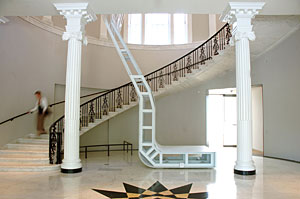The Museum of the City of New York recently celebrated the completion of the first phase of an extensive, $97-million renovation and expansion plan designed by Polshek Partnership Architects. The most notable component of phase one is a new single-story, 3,000-square-foot glass pavilion attached to the rear of the existing building at 1220 Fifth Avenue. Other important features remain largely invisible because they’re located underground: the $28 million project adds two additional levels beneath the pavilion for a much-needed curatorial center, which provides environmental controls and equipment to help preserve the museum’s photographs, prints, textiles, and other artifacts. The museum’s entrance has also been restored, and outdoor terraces have been redesigned and landscaped.


Photos courtesy Polshek Partnership Architects
The original building, designed by Joseph H. Freedlander in 1932, was designated a city in landmark in 1967. The Polshek addition has the blessing of New York City’s Landmarks Preservation Commission. “People weighed in positively, but they did so in the belief that the time had arrived where one could append a contemporary work of architecture to a Georgian Revival building,” says James S. Polshek, FAIA. “This is a very pure addition. When you enter, it’s quite a new world. It has height and is very light.”
The expansion is designed as a three-phase project so that the museum can remain open during construction. Phase two, which is now under way, includes new office space on the fourth and fifth floors, the renovation of existing galleries and classrooms, the redesign of the museum shop, and the addition of climate control and an upgraded electrical system in the museum’s south wing. Phase three will involve the renovation of the north wing.
Polshek notes that it has been a long road: His firm designed an expansion plan for the museum in the mid ’80s, but it was scrapped due to lack of funding. The firm began working on the current plan in 2003. With the first phase finished, and full completion expected in 2011, Polshek says the museum “can now take its place amongst the great city museums of the world.”

Post a comment to this article
Report Abusive Comment